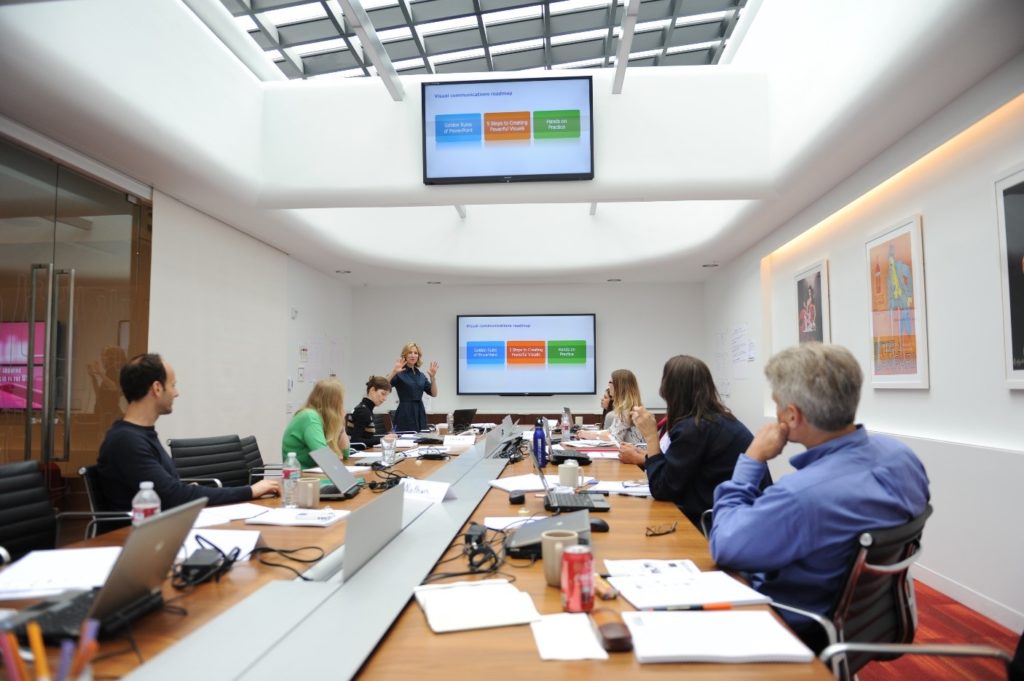Remember the last time you were stuck in a business presentation with endless bullets, heavy data, and text-filled slides? Last week? Yesterday? Right now? Business meetings are notoriously boring, which is why companies like Facebook, Hewlett Packard and Pepsi are seizing upon a better way to communicate ideas in business — through the narrative device of storytelling.
What’s the big deal about storytelling? Why can’t sellers just get right to their product features, project managers to their spreadsheet data, or strategists to their recommendations? Because studies show that weaving data and facts into a story framework makes ideas stick much better than dry presentations.
Storytelling works better because it offers your audience an emotional connection to your ideas. Molecular biologist John Medina studies the link between emotion and recall. He says we internally repeat and think about information that we find compelling. Most of the time, that means emotional material — in other words, stories.
We remember what we feel, and as neuroscientist Antonio Damasio has found, emotions are even more important than logic when it comes to critical retention of the information needed for clear decision-making. If you want to make a presentation that is persuasive, that emotionally engages your audience, it needs to be about story.
But how do you actually incorporate effective story telling in your meetings and presentations? The Presentation Company (TPC) helps companies turn their employees into storytellers. They’ve developed a training to help people in business infuse storytelling into everyday communications. Here are their top three lessons for making your presentations great through storytelling.
Lesson 1: Know Your Audience
“What exactly is storytelling? Generally, it’s a way of laying out your ideas by (1) providing context and setting the stage; (2) making it relatable through well-developed characters; (3) acknowledging challenges by revealing conflict; and (4) resolving your story’s conflict in a way that’s emotionally satisfying,” explains The Presentation Company (TPC) founder Janine Kurnoff.
To address issues of personality and style as well as corporate culture, when working with a new company, TPC conducts pre-workshop interviews where they ask whether people at the company value storytelling. “If they don’t, it is more difficult, though not impossible, to teach them this new mode of operating,” Kurnoff explains.

She adds that in addition to understanding the culture of the company, it is paramount that you find out what kind of stories resonate within it. Product? Program Updates? Pitching? Persuasion? “Much of our training in storytelling is taught through examples. For the data junkies or wordy marketers, we pull from an array of stories that we feel will resonate most with that particular audience. Data people often have a harder time understanding the need for what they consider ‘fluffy’ storytelling. Examples of how data can be directly expressed through stories is critical.”
Lesson 2: People Love Concepts, but Tools Make Them Stick
“At the end of the day, when people are in the trenches, facing deadlines, they don’t have time for a lot of high concept and theory,” Kurnoff explains. “They need a time-saving, kick-starter that will organize facts, data, and ideas into a cohesive story.”
Based on this need, TPC built their own Visual Story Planner™ to provide a framework based on the classic storytelling arc that includes setting, characters, conflict, and resolution. It’s a step-by-step tool that helps teams develop a common language based on storytelling that helps them change how they approach presentation development.

“Another tool that saves time — and helps our clients make meaningful presentations — is a Visual Slide Library,” Kurnoff points out. “The library is a resource that lets people choose from an array of branded slides that are built for storytelling. Together with their Story Planner, staff members can easily pull together on-brand, targeted, visually powerful slides for each presentation.”

Lesson 3: Identify a storytelling advocate
Often after a company decides they want their employees to become storytellers, there are obstacles. “We have learned that there must be a relentless storytelling advocate within every organization,” Kurnoff notes. “In fact, the more advocates the better!”
To help the identified advocates, Kurnoff’s company arms them with a ‘walking deck’ to energize their internal selling. “A Walking Deck, as the names implies, is a storytelling explainer and course description that stands on its own. Big concepts like storytelling must be socialized into the existing culture. An effective way to do this is to let the self-navigating Walking Deck bubble up through the corporate food chain. Advocates aren’t always there to directly remind people of the value of storytelling, but a smart, streamlined, self-contained, educational resource like the Walking Deck makes it much easier to spread the idea around.”

To learn more about TPC’s visual storytelling courses click here.
REPRINTED WITH PERMISSION FROM Forbes.com
